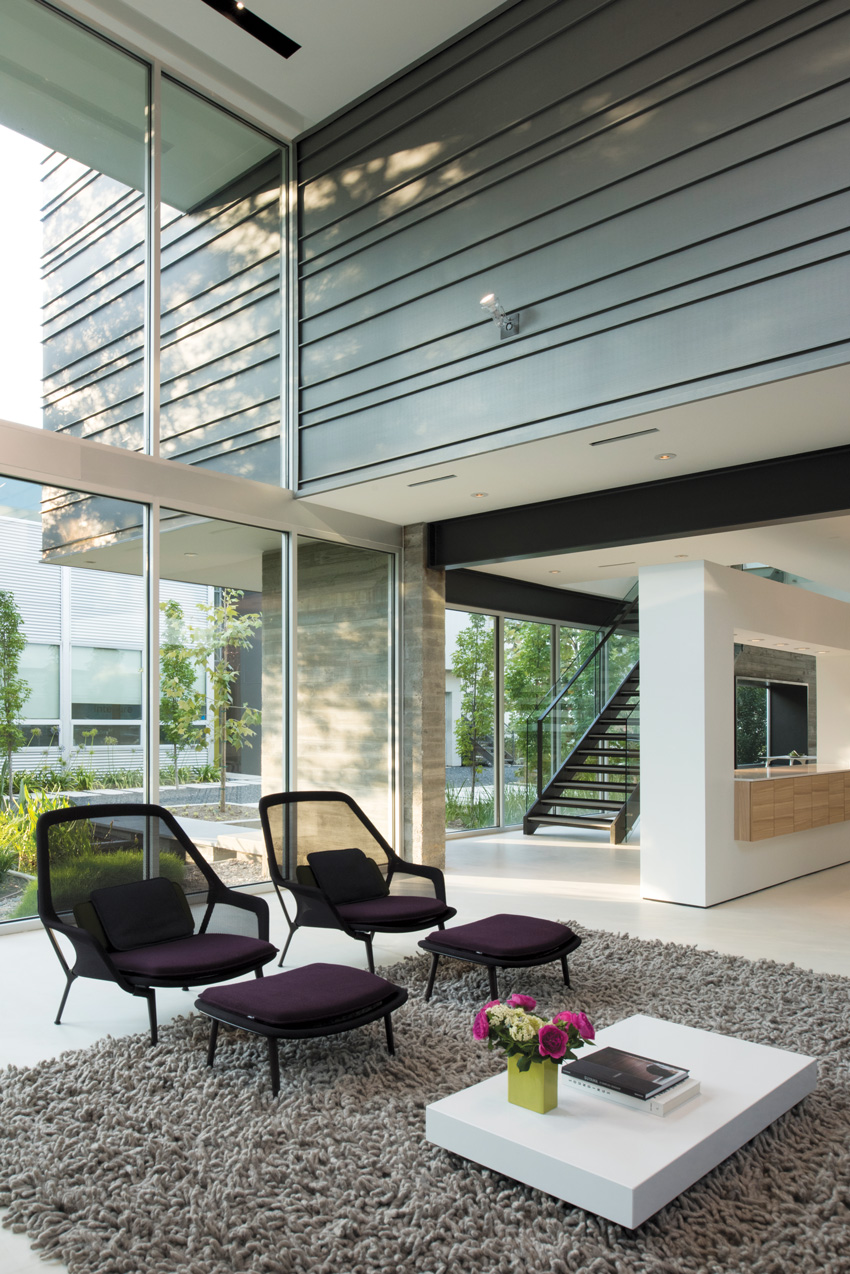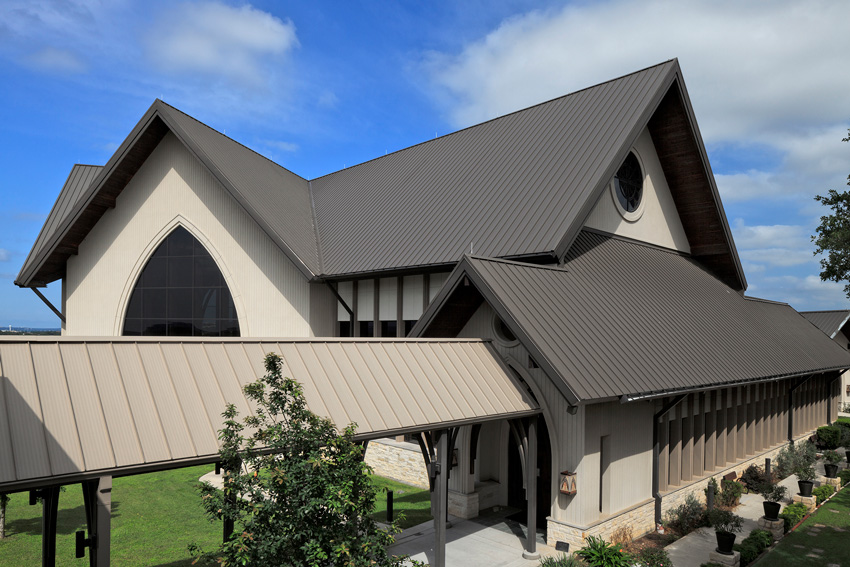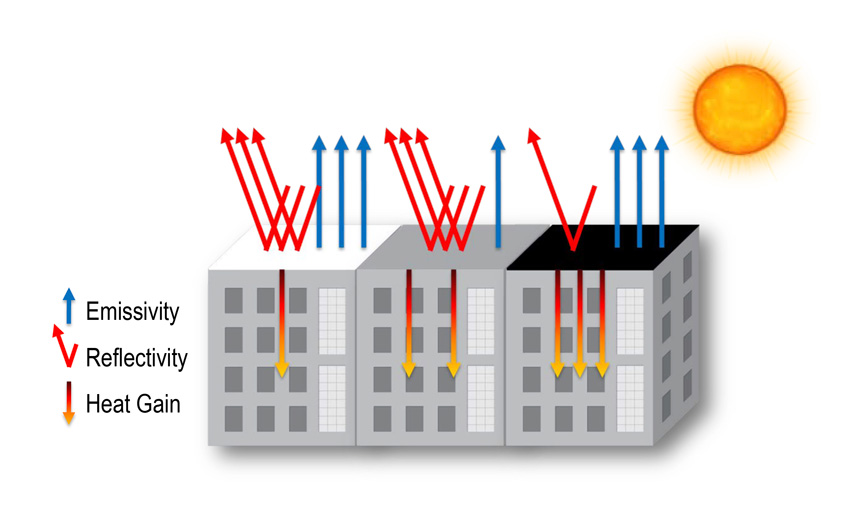Put the Pedal to the Metal
Lean and Green
Metal building products can reduce the load on a building’s foundations, resulting in significant savings in substructure design and construction, particularly with building extensions and brown-fill structures. In addition to roofing and cladding, metal-based technologies can be utilized as framing, composite floor slabs, non-load-bearing metal infill, and separating walls.

A 2016 MCA Chairman’s Award winner, the Tripartite House in Houston, capitalizes on metal’s durable, maintenance-free, and sustainable qualities.
Manufacturer: Umicore Building Products USA Inc.
Metal Fabricator and Installer: Ideal Roofing
The environmental impact of metal buildings was found to be lower in case studies comparing structural and envelope materials to load-bearing concrete, masonry, tilt-up, and steel-framed construction within the same basic building footprint, as analyzed in a whole building life-cycle analysis study by the Houston-based Walter P. Moore Associates on behalf of MBMA. The study concluded that in buildings where metal is typically most economical, LCA performance is also better, with the least embodied building material impact.4
Furthermore, metal lends itself to modular construction and its accompanying expedited construction benefits. Nothing quite compares to witnessing a building take shape within a matter of weeks, along with concomitant lower costs and speed to occupancy.
Compared to other materials, metal roofing and walls are relatively lightweight, providing less of an impact on the load-bearing foundations. Installation is much quicker than with other heavier and bulkier wall materials, resulting in significant labor and scheduling savings. In addition, metal roofs and walls can be erected even in inclement weather conditions, allowing construction to proceed and enabling contractors to move forward with interior work.
Longevity and Durability
Almost impervious to pests, able to withstand extreme weather, and noncombustible, metal roofs are unmatched in durability and longevity. Many manufacturers’ warranty their metal roofs for decades, and the expected lifetime of a metal roof can be significantly longer.
In fact, an MCA study reports that certain metal roof systems can have a service life of at least 60 years. Most noteworthy, the study has been verified by the third-party Athena Sustainable Materials Institute (ASMI), a nonprofit research collaborative that assesses the life cycle of various products within the construction sector to deliver accurate, essential information about the footprint of projects or materials.5
“Metal walls and roof systems contribute to a high-performing building envelope in so many ways,” affirms Lee. “When we’re discussing wall-panel systems, there’s the high insulation value, no need for thermal bridging of wall framing, low maintenance, long life, and resistance to moisture and mold. With regard to roof systems, there’s the high SRI, low maintenance and long life, and the fact that it’s PVC free and provides a clean surface for rainwater harvesting. For both walls and roof systems, the recycled steel content is a clear plus.”
Metal can be bent and shaped to fit a structure, allowing these roofs to last typically two to three times longer than asphalt shingles.
As an added bonus, maintenance is practically nonexistent. Property managers and owners report that their metal roofs require little or no regular maintenance. Metal-roof owners spent a mere 3.5 percent in maintenance costs, as compared to 19 percent for single-ply roofs and 28.5 percent for asphalt, according to a BOMA International white paper, “Metal Roofs and Walls, Promoting the Future of ‘Green’ and Sustaining the Environment.”6

Photo courtesy of Drexel Metals
At Emmaus Catholic Church in Lakeway, Texas, the scope of this project involved the design and construction of a new 600-seat sanctuary with church offices and fellowship areas. Metal roofing beautifully tops the structures.
Cool Roofing
In addition to metal’s long-lasting durability, metal roofs are a great candidate for cool roofing. As light-colored roof surfaces reflect heat away from the building, cooling loads can be shifted to non-peak hours, thereby evening out the energy load. In addition to noted energy savings, this helps prevent the grid from overloading during high-demand periods of time.

Image courtesy of MCA
Comparing the emissivity, reflectivity, and solar heat gain levels to white, gray, and black roof membranes, the absorbed heat in the light-colored membrane is much less than the darker rooftop.
Furthermore, the heat island effect is real and significant, especially in urban areas where air temperature can range from 6 to 12 degrees Fahrenheit higher than in outlying areas. In a city, the many dark areas and minimal greenery combine to provide less shade, less natural cooling, and a lot of heat being held in one place by all the buildings.
Cool roofing inherently replaces some of those black surfaces with a reflective alternative to lower the ambient air temperature, while the building it covers also requires less insulation. In sunny California, the Lawrence Berkeley National Library (LBNL) found that the surface temperature on a roof decreases by about 1 degree Fahrenheit for every 1 percent increase in roof reflection. Concurrently, it found that every 10 percent increase in roof reflectance resulted in decreased heating and cooling costs at approximately $0.02 annual savings per square foot. This varies with climates and utility rates but nevertheless demonstrates a direct link between cash savings and cool roofs.7
Also significant, the LBNL studied the effect of membrane roof colors on a retail store in Austin. It found that light-colored or white membranes can lower the temperature on the surface of a roof by more than 40 degrees Fahrenheit as compared to a membrane in a dark or black color. When the store switched from a black to a white membrane, the average surface temperature that summer dropped from 168 degrees Fahrenheit to 126 degrees Fahrenheit.
The Energy Efficiency & Renewable Energy Building Technology Program’s guide Selecting Cool Roofs from the U.S. Department of Energy states that where roof failure is mainly caused by heat-related degradation, it seems clear that a cool roof would outlast a similar roof in a darker color.8
Another LBNL study determined that increasing a roof’s albedo/whitening level could save millions in energy costs. “Clearly, FEMP should encourage use of cool roofs in new construction and during regularly scheduled reroofing to keep incremental costs down,” the report states.9 LBNL factors in additional recent data, estimating that were cool roofing to be utilized on 80 percent of commercial buildings in the United States, this would save 10,400 gigawatt-hours of cooling energy, approximately $735 million in annual overall energy savings, and a lifetime energy savings of $11 billion.
Contributing some additional compelling data, researchers at the Oak Ridge National Laboratory (ORNL) estimated the amount of insulation that would have to be added to a dark roof in order to achieve the energy savings provided by cool roofs. They concluded that an average R-9 value in insulation would be required to enable dark-colored membranes to deliver the same cooling cost savings as reflective roofs.10
In another study, ORNL’s Buildings Technology Center used an emission meter and a solar-spectrum reflectometer in a three-year study of the service life and energy efficiency of metal roofing systems. Researchers concluded that the high solar reflectivity and emissivity levels of cool metal roofing can greatly mitigate urban heat island effects.10 In addition, unpainted metal roofs demonstrate very high solar reflectance levels—depending on the color—from 10 to 75 percent, compared to 5 to 25 percent reflectivity for an asphalt roof.









